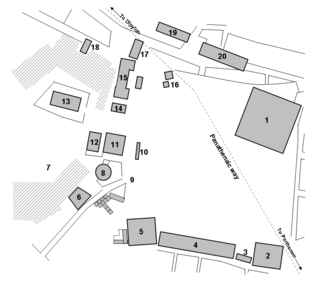 W
WThe Altar of the Twelve Gods, was an important altar and sanctuary at Athens, located in the northwest corner of the Classical Agora. The Altar was set up by Pisistratus the Younger, during his archonship, in 522/1 BC. It marked the central point from which distances from Athens were measured and was a place of supplication and refuge.
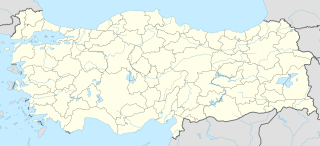 W
WApollonos Hieron was an ancient city of Lydia.
 W
WThe Temple of the Delians is the largest of the three cult temples dedicated to Apollo within the temenos of the Sanctuary of Apollo on the Greek island of Delos. It is also known as the Great Temple or the Delian Temple of Apollo.
 W
WDelphi, in legend previously called Pytho (Πυθώ), in ancient times was a sacred precinct that served as the seat of Pythia, the major oracle who was consulted about important decisions throughout the ancient classical world. The oracle was international in character and also fostered sentiments of Greek nationality, even though the nation of Greece was centuries away from realization. The ancient Greeks considered the centre of the world to be in Delphi, marked by the stone monument known as the omphalos (navel). The sacred precinct was in the region of Phocis, but its management had been taken away from the Phocians, who were trying to extort money from its visitors, and had been placed in the hands of an amphictyony, or committee of persons chosen mainly from Central Greece. According to the Suda, Delphi took its name from the Delphyne, the she-serpent (drakaina) who lived there and was killed by the god Apollo.
 W
WThe Temple of Apollo, god of music, harmony, light, healing, and oracles occupied the most important and prominent position in the Delphic Panhellenic Sanctuary. The edifice with the partially restored colonnade visible today dates to the 4th century BC; it is the third temple built at the same place. The famous oracle, the Pythia, operated inside the temple, the location chosen, according to one tradition, due to a sacred chasm beneath the site emitting vapors, which were inhaled by the Pythia. Some ancient writers state that the Pythia then entered a state of delirium and uttering inarticulate cries, which were then turned into equivocal oracles by the priests. This interpretation is controversial, and has been challenged by scholars such as Joseph Fontenrose and Lisa Maurizio, who argue that the ancient sources uniformly represent the Pythia speaking intelligibly, and giving prophecies in her own voice.
 W
WBassae is an archaeological site in Oichalia, a municipality in the northeastern part of Messenia, Greece. In classical antiquity, it was part of Arcadia. Bassae lies near the village of Skliros, northeast of Figaleia, south of Andritsaina and west of Megalopolis. It is famous for the well-preserved mid- to late-5th century BC Temple of Apollo Epicurius.
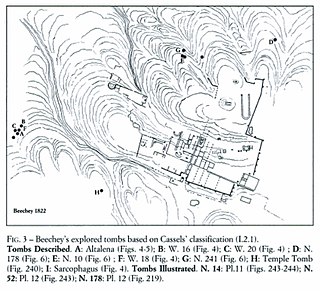 W
WThe Necropolis of Cyrene is a necropolis located between Cyrene, Libya and the ancient port of Apollonia, at the western slope of the Wadi Haleg Shaloof hill. It is around 10 square kilometres in size. With terraced archaic tombs, the cemetery is near the ancient road to Apollonia. The necropolis is today partially lost, parts were bulldozed in 2013. The UNESCO classified the site in 1982 as a World Heritage site, and added Cyrene in 2017 to its List of World Heritage in Danger.
 W
WThe Temple of Apollo Palatinus was a temple on the Palatine Hill of ancient Rome, which was first dedicated by Augustus to his patron god Apollo. It was only the second temple in Rome dedicated to the god, after the Temple of Apollo Sosianus. It was sited next to the Temple of Cybele. Prior to excavations in 1956, these remains were thought to belong to the Temple of Jupiter Victor.
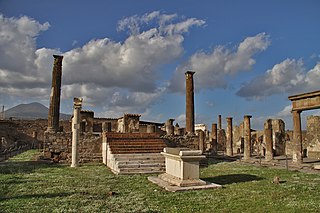 W
WThe Temple of Apollo is a Roman temple built in 120 BC and dedicated to the Greek and Roman god Apollo in the ancient Roman town of Pompeii, southern Italy.
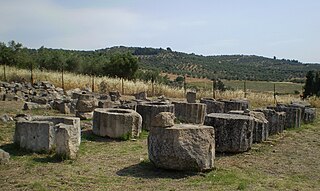 W
WAbae was an ancient town in the northeastern corner of ancient Phocis, in Greece, near the frontiers of the Opuntian Locrians, said to have been built by the Argive Abas, son of Lynceus and Hypermnestra, and grandson of Danaus. This bit of legend suggests an origin or at least an existence in the Bronze Age. Its protohistory supports a continued existence in Iron-Age antiquity. It was famous for its oracle of Apollo Abaeus, one of those consulted by Croesus, king of Lydia, and Mardonius, among others. The site of the oracle was rediscovered at Kalapodi and excavated in modern times. The results confirm an archaeological existence dating from the Bronze Age, as is suggested by the lore.
 W
WThe sanctuary of Apollo Maleatas is located on a low hill on Mount Kynortion, east of the sanctuary of Asklepios at Epidaurus.
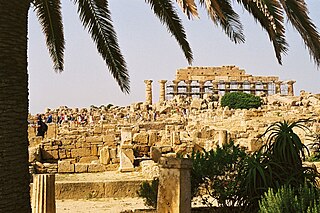 W
WTemple C at Selinus, Trapani (Sicily), is a Greek temple in the doric style. It was one of the most ancient of the temples at Selinus, having probably been built on the acropolis a little after the middle of the sixth century BC, although its dating is controversial. The temple was the object of archaeological research in the nineteenth century and beginning of the twentieth century and later the remains of a long stretch of the northern colonnade received anastylosis in 1929. After a twelve-year-long restoration, in 2011 the colonnade was freed from scaffolding and made properly visible once more.
 W
WThe Temple of Apollo is a Roman temple built around 150 A.D. during the Pax Romana era in the ancient Carian town of Side, in southern Turkey on the Mediterranean Sea coast and dedicated to Apollo, the Greek and Roman god of music, harmony and light.
 W
WThe Temple of Apollo Sosianus is a Roman temple dedicated to Apollo in the Campus Martius, next to the Theatre of Marcellus and the Porticus Octaviae, in Rome, Italy. Its present name derives from that of its final rebuilder, Gaius Sosius.
 W
WThe Temple of Apollo is one of the most important ancient Greek monuments on Ortygia, in front of the Piazza Pancali in Syracuse, Sicily, Italy.
 W
WAntioch on the Orontes was an ancient Greek city on the eastern side of the Orontes River. Its ruins lie near the current city of Antakya, Turkey, to which the ancient city lends its name.
 W
WDreros, also Driros, near Neapoli in the regional unit of Lasithi, Crete, is a post-Minoan archaeological site, 16 km northwest of Agios Nikolaos. Known only by a chance remark of the 9th-century Byzantine grammarian Theognostus, archaeology of the site shows Dreros to have been initially colonised by mainland Greeks in the early Archaic Period about the same time as Lato and Prinias.
 W
WBassae is an archaeological site in Oichalia, a municipality in the northeastern part of Messenia, Greece. In classical antiquity, it was part of Arcadia. Bassae lies near the village of Skliros, northeast of Figaleia, south of Andritsaina and west of Megalopolis. It is famous for the well-preserved mid- to late-5th century BC Temple of Apollo Epicurius.
 W
WHamaxitus was an ancient Greek city in the south-west of the Troad region of Anatolia which was considered to mark the boundary between the Troad and Aeolis. Its surrounding territory was known in Greek as Ἁμαξιτία (Hamaxitia), and included the temple of Apollo Smintheus, the salt pans at Tragasai, and the Satnioeis river. It has been located on a rise called Beşiktepe near the village of Gülpınar in the Ayvacık district of Çanakkale Province, Turkey.
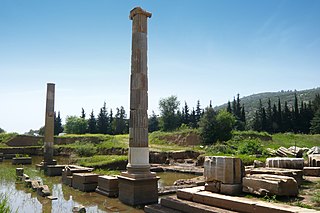 W
WClaros was an ancient Greek sanctuary on the coast of Ionia. It contained a temple and oracle of Apollo, honored here as Apollo Clarius. It was located in the territory of Colophon, which lay twelve kilometers to the north, one of the twelve cities of the Ionian League. The coastal city Notion lay two kilometers to the south. The ruins of the sanctuary are now found north of the modern town Ahmetbeyli in the Menderes district of Izmir Province, Turkey.
 W
WCorinth was a city-state (polis) on the Isthmus of Corinth, the narrow stretch of land that joins the Peloponnese to the mainland of Greece, roughly halfway between Athens and Sparta. The modern city of Corinth is located approximately 5 kilometres (3.1 mi) northeast of the ancient ruins. Since 1896, systematic archaeological investigations of the Corinth Excavations by the American School of Classical Studies at Athens have revealed large parts of the ancient city, and recent excavations conducted by the Greek Ministry of Culture have brought to light important new facets of antiquity.
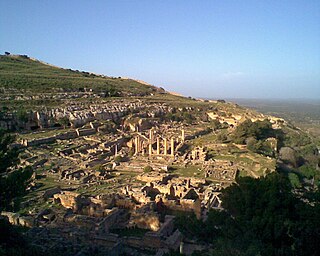 W
WCyrene was an ancient Greek and later Roman city near present-day Shahhat, Libya. It was the oldest and most important of the five Greek cities in the region. It gave eastern Libya the classical name Cyrenaica that it has retained to modern times. Located nearby is the ancient Necropolis of Cyrene.
 W
WDidyma was an ancient Greek sanctuary on the coast of Ionia in the domain of the famous city of Miletus. Apollo was the main deity of the sanctuary of Didyma, also called Didymaion. But it was home to both of the temples dedicated to the twins Apollo and Artemis. Other deities were also honoured within the sanctuary. The Didymaion was well renowned in antiquity because of its famed oracle. This oracle of Apollo was situated within what was, and is, the one of the world's greatest temples to Apollo. The remains of this Hellenistic temple belong to the best preserved temples of classical antiquity. Besides this temple other buildings existed within the sanctuary which have been rediscovered recently; a Greek theatre and the foundations of the above-mentioned Hellenistic temple of Artemis, to name but two.
 W
WGortyn, Gortys or Gortyna is a municipality, and an archaeological site, on the Mediterranean island of Crete 45 km (28 mi) away from the island's capital, Heraklion. The seat of the municipality is the village Agioi Deka. Gortyn was the Roman capital of Creta et Cyrenaica. The area was first inhabited around 7000 BC.
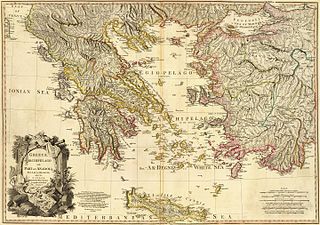 W
WMiletus was an ancient Greek city on the western coast of Anatolia, near the mouth of the Maeander River in ancient Caria. Its ruins are located near the modern village of Balat in Aydın Province, Turkey. Before the Persian invasion in the middle of the 6th century BC, Miletus was considered among the greatest and wealthiest of Greek cities.
 W
WThe Temple of Apollo Zoster is an ancient Greek temple, the remains of which are located at Vouliagmeni in Athens, Greece.